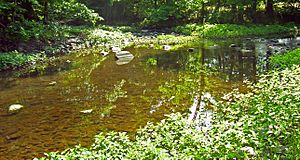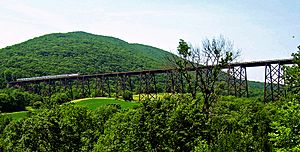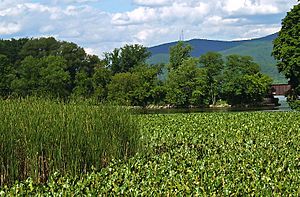Moodna Creek facts for kids
Quick facts for kids Moodna Creek |
|
|---|---|
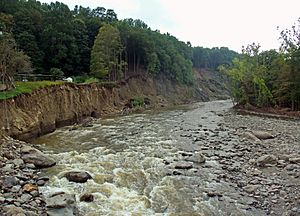
Moodna Creek from Forge Hill Rd. Bridge in New Windsor, showing widening of channel resulting from floods after Hurricane Irene
|
|

Moodna Creek and its watershed and major tributaries
|
|
| Native name | Waoraneck |
| Other name(s) | Murderers' Creek Murderer's Creek |
| Country | United States |
| State | New York |
| County | Orange |
| Towns | Cornwall, New Windsor, Blooming Grove |
| Villages | Washingtonville |
| Physical characteristics | |
| Main source | Otter Kill Goshen Reservoir No. 2, Town of Goshen 460 ft (140 m) 41°22′06″N 74°19′02″W / 41.36833°N 74.31722°W |
| 2nd source | Cromline Creek Tomahawk Lake, Blooming Grove 340 ft (100 m) 41°24′57″N 74°13′07″W / 41.41583°N 74.21861°W |
| River mouth | Hudson River Cornwall 0 ft (0 m) 41°27′13″N 74°01′00″W / 41.45361°N 74.01667°W |
| Length | 15.5 mi (24.9 km) |
| Basin features | |
| Basin size | 187.2 sq mi (485 km2) |
| Tributaries |
|
Moodna Creek is a small river in Orange County, New York. It flows into the Hudson River. It's about 15.5 miles (25 km) long. This makes it the longest stream that is completely inside Orange County.
Even though it's small compared to the Hudson River, Moodna Creek has shaped the land around it. Its watershed covers 187.2 square miles. This area includes not only its main starting streams but also Woodbury Creek. The watershed reaches as far as Warwick and 21 other towns. Near Salisbury Mills, a very long railroad bridge called the Moodna Viaduct crosses over the creek. It's the longest active railroad bridge east of the Mississippi River.
Contents
What's in a Name?
Before Europeans arrived, the creek was called Waoraneck. This was also the name of a local Native American tribe, the Waoraneck tribe.
For a long time, early records called the creek Murderer's Creek. One idea is that "Moodna" comes from the Dutch word moordenaars, which means "murderers." Another story says the name came from a sad event where an early family of settlers, the Stacys, were supposedly attacked along the creek. However, there's no real proof that this attack ever happened.
In the mid-1800s, a writer named Nathaniel Parker Willis lived near the creek. He helped make the name "Moodna" popular. He believed "Murderers' Creek" was a mistake. He thought it was meant to be the name of a chief, possibly Maringamus of the Waoraneck tribe, who lived nearby. By the early 1900s, "Moodna Creek" was used on most maps, but some people still used the older name.
The Creek's Journey
Moodna Creek begins where Cromline Creek and Otter Kill meet. This spot is near NY 208. The creek flows through forests and fields, sometimes running next to the highway. It then turns southwest and crosses NY 94.
The creek and Route 94 stay close for several miles. The Moodna then turns east again into Washingtonville. After the village, the creek enters the Town of Blooming Grove and then Cornwall. The Moodna valley widens near Schunemunk Mountain. At Salisbury Mills, the famous Moodna Viaduct crosses 193 feet overhead.
After the viaduct, the Moodna Creek turns south a bit. It follows the curve of Schunemunk Mountain's north side. It goes under the Thruway. The creek then flows into a narrower valley. It forms the eastern edge of the Storm King Art Center. Here, the creek gets even wider when Woodbury Creek joins it after flowing over a small dam.
Soon after, NY 32 crosses the creek. The wide, rocky stream winds between steep, wooded hills. It enters New Windsor. It crosses Old Forge Hill Road near Knox's Headquarters State Historic Site. Here, it also gains water from Silver Stream, its main northern tributary. The creek then passes its last road crossing at US 9W. Finally, it bends south back into Cornwall. It empties into the Hudson River among tidal marshes.
Wildlife and Nature
The 75 acres of tidal marsh at the creek's mouth are very important. This area is between Route 9W and the Hudson River. It is home to several rare plants and unique natural communities. Fish like striped bass swim up the creek from the ocean to lay their eggs here.
This rich fish supply attracts many birds. Bald eagles and ospreys have been seen hunting for fish in the Moodna's marshes. Bald Eagles have even been seen nesting near the Black Meadow Creek.
Two special frog and reptile species live along the Moodna Creek. One is the Northern cricket frog. This frog is New York's only endangered frog species. Its largest population lives along the Black Meadow Creek, which flows into the Moodna.
The water quality in the creek is generally good. However, there is some treated water from the Town of New Windsor's sewage treatment plant that flows into it. In 2003, an environmental group called Riverkeeper worked with the town. They helped make sure the town fixed some pipes that were leaking into the creek. The town also agreed to improve public access to the water.
A Look at History
The first European settlers in what is now Orange County were 25 Scottish families. They settled at the mouth of the Moodna Creek in 1685.
The creek was an important path for soldiers during the American Revolutionary War. It helped them move around the area.
In the past, the creek was part of the border between Orange and Ulster counties. This changed over time as new counties were formed.
Heavy rains in April 2007 caused the creek to flood. This happened especially around Washingtonville. Roads were blocked, and many residents had to leave their homes. In 2011, Hurricane Irene also caused the creek to swell. It washed out parts of roads and made a bridge unstable.
Fun on the Creek
The six miles of Moodna Creek between Woodbury Creek and Old Forge Hill Road are popular for whitewater kayaking. The difficulty levels range from easy to challenging.
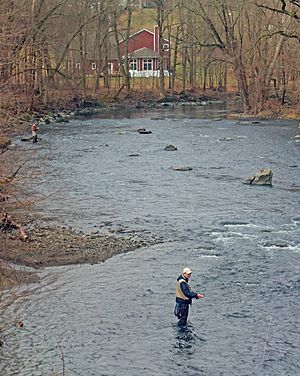
People also enjoy fishing in the creek, especially above the tidal marshes. The New York State Department of Environmental Conservation regularly adds brown and rainbow trout to Moodna Creek. This helps keep the fish population healthy for anglers.
Moodna Creek in Pop Culture
Moodna Creek has even appeared in TV shows! In season three of Turn: Washington's Spies, there's a battle scene at the Moodna. Patriots try to stop Loyalists from spreading too much money. This was meant to cause money problems in the United States.
Creek Connections: Tributaries
Many smaller streams flow into Moodna Creek, adding to its waters. These are called tributaries:
- Silver Stream
- Woodbury Creek
- Baby Brook
- Perry Creek
- Satterly Creek
- Black Meadow Creek
- Otter Kill


